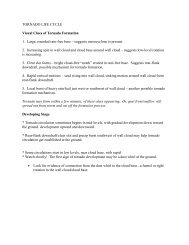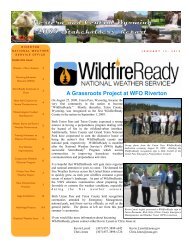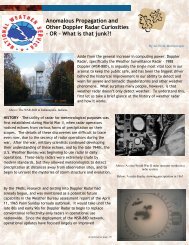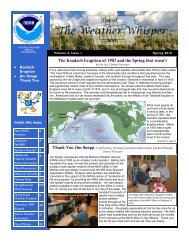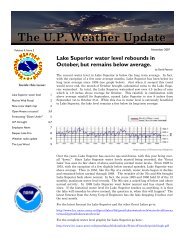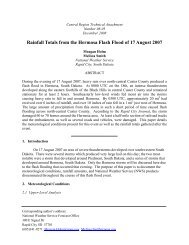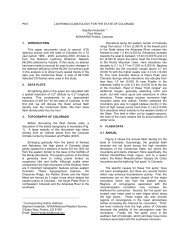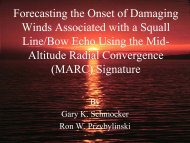Commercial Buildings, Was 93 Million Dollars Making It The
Commercial Buildings, Was 93 Million Dollars Making It The
Commercial Buildings, Was 93 Million Dollars Making It The
Create successful ePaper yourself
Turn your PDF publications into a flip-book with our unique Google optimized e-Paper software.
Narrative Summary<br />
In 2003, one of the worst blizzards since historic records began in 1872 struck metro<br />
Denver with a vengeance. Heavy wet snow accumulating to around 3 feet in the city and<br />
to more than 7 feet in the foothills brought transportation to a near standstill. North winds<br />
sustained to 30 mph with gusts as high as 41 mph produced drifts to 6 feet in parts of the<br />
Denver Metro area. <strong>The</strong> estimated cost of property damage alone, not including large<br />
commercial buildings, was <strong>93</strong> million dollars making it the costliest snowstorm ever.<br />
Mayor Wellington Webb of Denver said "This is the storm of the century, a backbreaker,<br />
a record breaker, a roof breaker." Two people died in aurora from heart attacks after<br />
shoveling the heavy wet snow. <strong>The</strong> National Guard sent 40 soldiers and 20 heavy duty<br />
vehicles to rescue stranded travelers along I-70 east of Gun Club Road. <strong>The</strong> heavy wet<br />
snow caused roofs of homes and businesses to collapse. <strong>The</strong> snow also downed trees,<br />
branches, and power lines. Two people were injured when the roofs of their homes<br />
collapsed. In Denver alone at least 258 structures were damaged. Up to 135,000<br />
people lost power during the storm, and it took several days for power to be restored in<br />
some areas. Denver International Airport was closed, stranding about 4,000 travelers.<br />
<strong>The</strong> weight of the heavy snow caused a 40-foot gash in a portion of the tent roof, forcing<br />
the evacuation of that section of the main terminal building.
Avalanches in the mountains and foothills closed many roads including I-70, stranding hundreds of skiers and<br />
travelers. Along I-70, an avalanche released by the Colorado Department of Transportation blocked the<br />
interstate in both directions for several hours. Several residences between Bakerville and Silver Plume were<br />
evacuated because of the high avalanche danger. At Eldora ski area, 270 skiers were stranded when an<br />
avalanche closed the main access road. After the storm ended, a military helicopter had to ferry food to the<br />
resort until the road could be cleared. <strong>The</strong> heavy snow trapped thousands of residents in their foothills<br />
homes in Jefferson county for several days. Two homes burned to the ground when fire crews could not reach<br />
the residences. Some schools remained closed well into the following week. <strong>The</strong> storm officially dumped<br />
31.8 inches of snow at the site of the former Stapleton International Airport, the most snowfall from a single<br />
storm since the all-time record snowfall of 37.5 inches on December 4-5, 1913. <strong>The</strong> storm made March 2003<br />
the snowiest march on record, the 4th snowiest month on record, and the 5th wettest March on record. <strong>The</strong><br />
22.9 inches of snow on the 18th into the 19th was the greatest 24 hour snowfall ever recorded in the city<br />
during the month of March. <strong>The</strong> storm was also a drought-buster, breaking 19 consecutive months of below<br />
normal precipitation in the city. Snowfall across metro Denver and in Fort Collins ranged from 2 feet to more<br />
than 3 feet. <strong>The</strong> highest amounts included; 40 inches in Aurora, 38 inches in Centennial and 6 miles east of<br />
Parker, 37 inches at Buckley AFB, 35 inches in southwest Denver, 34 inches in Louisville, 32 inches in Arvada,<br />
31 inches in Broomfield and Westminster, and 22.5 inches in Boulder. In the foothills, snowfall ranged from 3<br />
feet to more than 7 feet. Some of the most impressive storm totals included; 87.5 inches atop Fritz Peak and<br />
in Rollinsville, 83 inches at Cabin Creek, 74 inches near Bergen Park, 73 inches northwest of Evergreen, 72<br />
inches in Coal Creek Canyon, 70 inches at Georgetown, 63 inches near Jamestown, 60 inches near Blackhawk,<br />
55 inches at Eldora Ski Area, 54 inches 8 miles west of Sedalia, and 46.6 inches at Ken Caryl Ranch. Locations<br />
from east of Greeley to Limon received almost all rain from this event, with rainfall amounts ranging from 1 to<br />
2 .5 inches.
Storm Center on March 18, 2003
Profiler<br />
from<br />
Platteville<br />
CO,<br />
showing<br />
deep and<br />
strong<br />
easterly<br />
upslope<br />
winds<br />
created by<br />
deep and<br />
powerful<br />
storm to<br />
our South
<strong>The</strong> Top 10 Snowstorms<br />
(historical perspective)<br />
Date<br />
Denver Totals<br />
Dec 1-5, 1913 45.7”<br />
Mar 17-19, 2003 31.8”<br />
Nov 2-4, 1946 30.4”<br />
Dec 24, 1982 23.8”<br />
Apr 21-23, 1885 23.0”<br />
Oct 20-23, 1906 22.7”<br />
Oct 24-25, 1997 21.9”<br />
Nov 26-27, 1983 21.5”<br />
Dec 20-21, 2006 20.7”<br />
Jan 29-31, 1883 19.3”
Tuesday,<br />
March 18,<br />
2003<br />
satellite<br />
imagery.<br />
Note:<br />
Deep<br />
plume of<br />
gulf<br />
moisture<br />
streaming<br />
into<br />
Colorado<br />
from the<br />
Southeast
Snow Totals
Snow Totals ski areas
Post-storm visible image
Post-storm visible satellite image – close up
East Boulder:
Coal Creek Canyon




